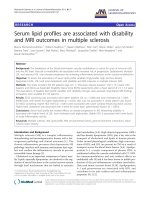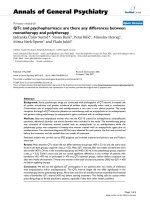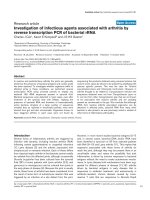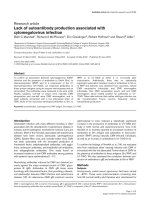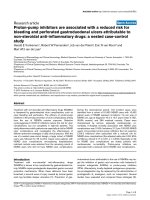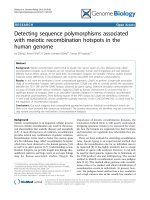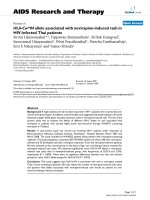Báo cáo y học: "HIV-1 integrase polymorphisms are associated with prior antiretroviral drug exposure" doc
Bạn đang xem bản rút gọn của tài liệu. Xem và tải ngay bản đầy đủ của tài liệu tại đây (185.36 KB, 3 trang )
BioMed Central
Page 1 of 3
(page number not for citation purposes)
Retrovirology
Open Access
Correspondence
HIV-1 integrase polymorphisms are associated with prior
antiretroviral drug exposure
Sebastiaan J van Hal*
1
, Belinda Herring
1
, Zaquan Deris
1,3
, Bin Wang
2
,
Nitin K Saksena
2
and Dominic E Dwyer
1
Address:
1
Centre for Infectious Diseases and Microbiology, ICPMR Westmead Hospital, University of Sydney, Westmead 2145, NSW, Australia,
2
Retroviral Genetics Division, Centre for Virus Research, Westmead Millennium Institute, Westmead 2145, NSW, Australia and
3
Universiti Sains
Malaysia, Department of Medical Microbiology and Parasitology, Kota Bharu, Kelantan, Malaysia
Email: Sebastiaan J van Hal* - ; Belinda Herring - ;
Zaquan Deris - ; Bin Wang - ; Nitin K Saksena - ;
Dominic E Dwyer -
* Corresponding author
Abstract
In a recent summary of integrase sequences, primary integrase inhibitor mutations were rare. In a
review of integrase inhibitor-naïve Australian HIV-1 sequences, primary mutations were not
identified, although the accessory mutation G140S was detected. A link with previous antiretroviral
therapy, intra-subtype B divergence across the integrase gene and transmission of integrase
polymorphisms were also noted. Based on these findings, we would recommend ongoing
surveillance of integrase mutations, and integrase region sequencing for patients prior to
commencement of integrase inhibitors.
Correspondence
We congratulate Rhee and colleagues for their extensive
review of the natural variation of HIV-1 integrase in 1500
integrase sequences from B and non-B HIV-1 subtypes [1].
This study provides significant insights into integrase
inhibitor (INIs) resistance mutations and polymor-
phisms, and forms an essential component in guiding
therapeutic decisions. This has become even more imper-
ative since the licensing of raltegravir (RAL) for the treat-
ment of antiretroviral (ARV)-experienced HIV-1 infected
patients, following the definitive BENCHMRK 1 and 2 tri-
als [2,3].
In both BENCHMRK trials, treatment failure was associ-
ated with the selection of signature, or primary, INI muta-
tions. These occur in one of two main pathways, either
N155H or Q148H/K/R. A possible alternative and third
pathway, Y143R/C, also exists. Primary INI mutations
were detected by Rhee et al. in their review of the Stanford
HIV Database in only 3 isolates (each with a single pri-
mary INI mutation N155H, Q148H and Q148K). We are
aware of possibly two additional isolates, one from an
Australian isolate bearing N155H in an INI-naïve patient
(GenBank Accession No. AF042104
) and a second resist-
ant isolate published by Myers et al. [4]. Therefore,
although primary mutations remain rare in INI treatment-
naïve individuals, their occurrence suggests that IN
sequencing should be considered in all patients prior to
INI therapy.
The role of accessory mutations in INI resistance is less
clear. It is known that pathway-specific accessory muta-
tions augment INI resistance in the presence of the pri-
mary mutations. However, the phenotypic effect of most
Published: 9 February 2009
Retrovirology 2009, 6:12 doi:10.1186/1742-4690-6-12
Received: 30 December 2008
Accepted: 9 February 2009
This article is available from: />© 2009 van Hal et al; licensee BioMed Central Ltd.
This is an Open Access article distributed under the terms of the Creative Commons Attribution License ( />),
which permits unrestricted use, distribution, and reproduction in any medium, provided the original work is properly cited.
Retrovirology 2009, 6:12 />Page 2 of 3
(page number not for citation purposes)
isolated single accessory mutations (i.e. T97A, V151I,
G163R, I203M and S230N) remains unknown. In con-
trast, isolated L74A/I/M has no effect on in vitro resistance
while G140S is associated with an in vitro 5–10 fold
decrease in susceptibility [4] (Personal communication
with Merck Sharp & Dohme). This mutation is not only
responsible for partial RAL resistance but also restores
viral fitness when combined with the Q148R/H mutation
[5]. G140S was not documented by Rhee et al. in their
review [1]. However, in a small study conducted at West-
mead Hospital, Sydney, Australia, G140S was detected in
2 INI-naïve patients, as were the other accessory muta-
tions: L74I/M (n = 8), T97A (n = 2), V151I (n = 3) and
I203M (n = 4). In this study, plasma from 133 INI-naïve
patients were sequenced (GenBank Accession Numbers
FJ554674
–FJ554806) across integrase. Most sequences
belonged to HIV-1 subtype B (n = 109). The remaining 25
sequences include subtype A (n = 4); subtype C (n = 8);
subtype G (n = 4), CRF02_AG (n = 3), CRF01_AE (n = 2)
and CRF33_01B (n = 3). Using the same HIV-1 subtype B
consensus sequence as Rhee and colleagues, similar sub-
type-specific consensus residues were detected. For the
newly described CRF33_01B subtype (not studied by
Rhee et al.) several polymorphisms were detected in all
sequences i.e. V31I, T112V, T125A [6]. Although other
residues were similar to other non-B subtypes (varying
from the consensus B subtype), no firm conclusions can
be made because the number of CRF33_01B sequences
studied was small.
The influence of prior ARV therapy (not including INIs)
was not addressed by Rhee et al. Interestingly, we found
that previous ARV therapy was associated with greater IN
divergence (the mean intra-subtype B divergence was
5.1% +/- 0.17 in 59 samples from treatment-experienced
patients compared to a mean of 3.8% +/- 0.18 in 50 treat-
ment-naïve samples; p < 0.01). This finding suggests that
ARV-induced changes in other parts of the HIV-1 genome
may be linked to integrase polymorphisms. This is sup-
ported by data that has detected several integrase poly-
morphisms (e.g. M154I, V165I and M185L) positively
associated with specific RT mutations (F227L and T215Y)
in samples from treated individuals [7]. We were unable
to find any evidence to suggest this co-evolution at the IN
and RT sites, probably as a consequence of our small sam-
ple size. It still remains unknown whether the efficacy of
INIs is affected by previous ARV therapy selection pres-
sure. However, both G140S mutations in our study
occurred in samples from previously ARV-treated individ-
uals, suggesting that previous therapy may result in
reduced INI efficacy, and further supporting IN sequenc-
ing in patients contemplating INI therapy initiation.
A further question not addressed by Rhee and colleagues
was the potential transmission of IN polymorphisms. In
our study, three subtype B-infected patients (GenBank
Accession Numbers FJ554692
; FJ554718; FJ554739) were
known to have acquired their infection from the same
source. These samples all had IN sequencing performed
on plasma, cultured isolates and peripheral blood mono-
nuclear cells. Several IN polymorphisms (S24N, D25E,
T112I, S119P, T125A, K136Q, V201I, L234I and S283G)
were present in all three patients, suggesting that they
were readily transmitted. Interestingly, the sequences did
not vary by more than 0.2%, suggesting little sequence
variation between the various HIV-1 "compartments".
In conclusion, ongoing surveillance of integrase inhibitor
polymorphisms is important, including in non-subtype B
viruses. We suggest that IN sequencing should be under-
taken in all patients prior to INI commencement to enable
further elucidation of resistance pathways, and determi-
nation of the significance of subtype-specific polymor-
phisms in both ARV-naïve and experienced individuals.
Consent and ethics approval HREC 2008/3/4.10
(2750)
Patient consent was deemed unnecessary by the local Eth-
ics committee for several reasons: Antiviral resistance test-
ing is the standard of care for all Australian HIV infected
patients. Stored samples used for previous antiviral resist-
ance testing were available therefore no patients were
approached for this study to provide new blood samples.
Furthermore, it was felt that this testing could potentially
benefit the patient in future when integrase inhibitors
may be required in the treatment regimen.
Competing interests
D. Dwyer is a member of the advisory boards for Merck
Sharp & Dohme Australia and other local pharmaceutical
companies. Dr S. van Hal has received sponsorship to
attend a local HIV conference from Merck Sharp & Dohme
Australia
Authors' contributions
DED, NKS conceived the study. SJvH, BH, BW and DZ per-
formed the sequences and subsequent analysis. SJvH
wrote the paper. All authors have read and approved the
final manuscript.
Acknowledgements
Funding for this project was provided by an educational grant from Merck
Sharp & Dohme, Australia
References
1. Rhee SY, Liu TF, Kiuchi M, Zioni R, Gifford RJ, Holmes SP, Shafer RW:
Natural variation of HIV-1 group M integrase: implications
for a new class of antiretroviral inhibitors. Retrovirology 2008,
5:74.
2. Cooper DA, Steigbigel RT, Gatell JM, Rockstroh JK, Katlama C, Yeni
P, Lazzarin A, Clotet B, Kumar PN, Eron JE, Schechter M, Markowitz
M, Loutfy MR, Lennox JL, Zhao J, Chen J, Ryan DM, Rhodes RR, Killar
JA, Gilde LR, Strohmaier KM, Meibohm AR, Miller MD, Hazuda DJ,
Publish with BioMed Central and every
scientist can read your work free of charge
"BioMed Central will be the most significant development for
disseminating the results of biomedical research in our lifetime."
Sir Paul Nurse, Cancer Research UK
Your research papers will be:
available free of charge to the entire biomedical community
peer reviewed and published immediately upon acceptance
cited in PubMed and archived on PubMed Central
yours — you keep the copyright
Submit your manuscript here:
/>BioMedcentral
Retrovirology 2009, 6:12 />Page 3 of 3
(page number not for citation purposes)
Nessly ML, DiNubile MJ, Isaacs RD, Teppler H, Nguyen BY, BENCH-
MRK Study Teams: Subgroup and resistance analyses of ralte-
gravir for resistant HIV-1 infection. N Engl J Med 2008,
359:355-65.
3. Steigbigel RT, Cooper DA, Kumar PN, Eron JE, Schechter M,
Markowitz M, Loutfy MR, Lennox JL, Gatell JM, Rockstroh JK, Katlama
C, Yeni P, Lazzarin A, Clotet B, Zhao J, Chen J, Ryan DM, Rhodes RR,
Killar JA, Gilde LR, Strohmaier KM, Meibohm AR, Miller MD, Hazuda
DJ, Nessly ML, DiNubile MJ, Isaacs RD, Nguyen BY, Teppler H,
BENCHMRK Study Teams: Raltegravir with optimized back-
ground therapy for resistant HIV-1 infection. N Engl J Med
2008, 359:339-54.
4. Myers RE, Pillay D: Analysis of natural sequence variation and
covariation in human immunodeficiency virus type 1 inte-
grase. J Virol 2008, 82:9228-35.
5. Delelis O, Malet I, Na L, Tchertanov L, Calvez V, Marcelin AG, Subra
F, Deprez E, Mouscadet JF: The G140S mutation in HIV inte-
grases from raltegravir-resistant patients rescues catalytic
defect due to the resistance Q148H mutation. Nucleic Acids
Res 2009 in press.
6. Wang B, Lau KA, Ong LY, Shah M, Steain MC, Foley B, Dwyer DE,
Chew CB, Kamarulzaman A, Ng KP, Saksena NK: Complex pat-
terns of the HIV-1 epidemic in Kuala Lumpur, Malaysia: evi-
dence for expansion of circulating recombinant form
CRF33_01B and detection of multiple other recombinants.
Virology 2007, 367:288-97.
7. Ceccherini-Silberstein F, Malet I, Fabeni L, Svicher V, Gori C, Dimonte
S, et al.: Specific mutations related to resistance to HIV-1 inte-
grase inhibitors are associated with reverse transcriptase
mutations in HAART-treated patients. Antivir Ther 2007.

